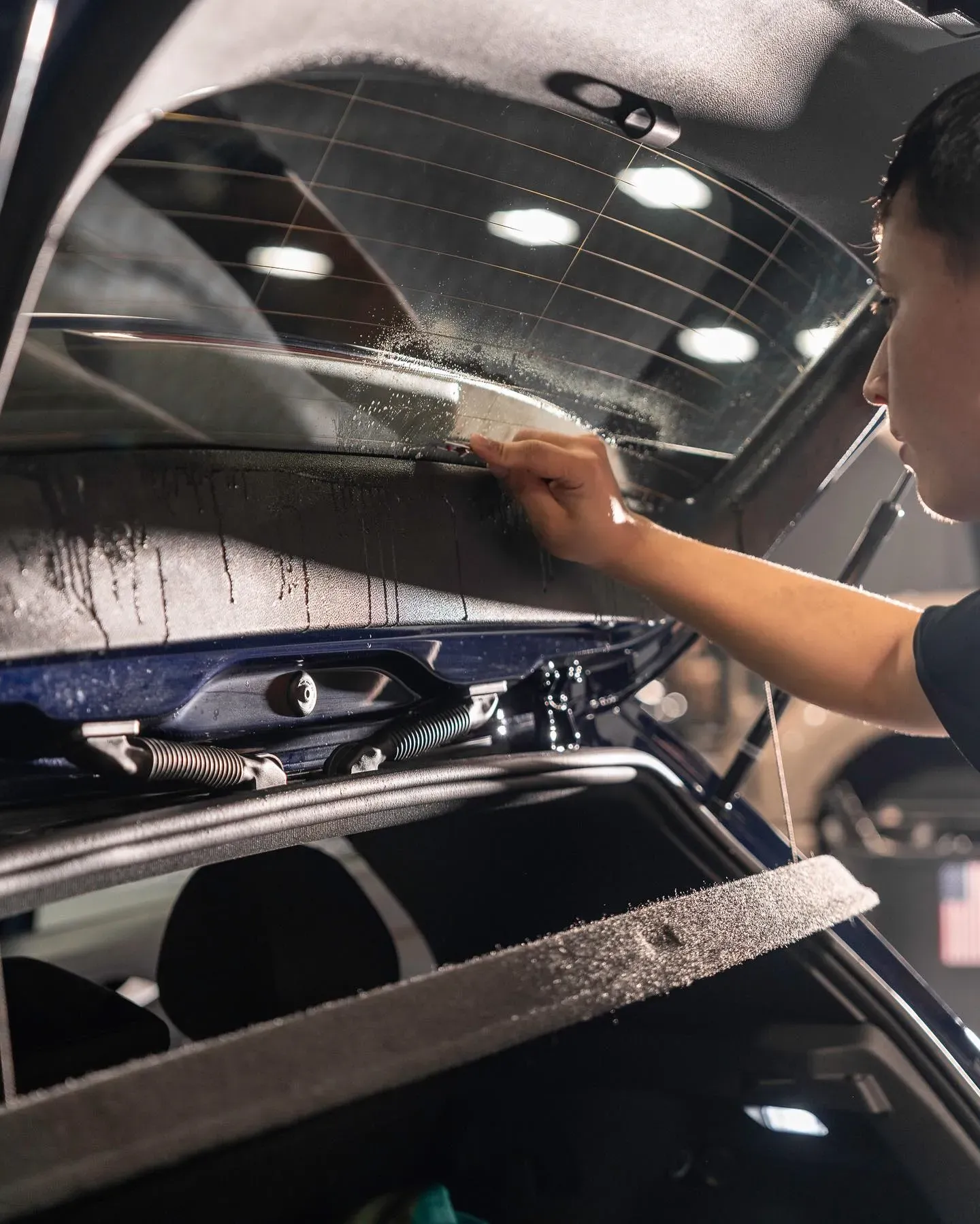PPF Yellowing: Uncovering the Myth and Ensuring Clarity and Durability
When you think about protecting your vehicle's paint, you might wonder if using a paint protection film (PPF) is worth the investment. After all, who wants to drive around with a car that looks faded or worn out? In this article, we’ll explore the reality behind PPF yellowing—a concern that has confused many. With modern advancements in technology, today’s PPFs are designed to stand strong against the elements without losing their clarity. To keep your car looking new, you must learn how these films work and what they can do. Let’s dive into the facts!
Advanced technologies in the design of modern paint protection films (PPF) significantly prevent yellowing, dispelling the myth that PPF inevitably discolors. Superior brands like SunTek feature clear-coated PPFs specifically engineered to resist discoloration, ensuring long-lasting clarity and durability for your vehicle's paint finish.
PPF Yellowing: Fact or Fiction?
The belief that paint protection film yellows is a misconception rooted in the characteristics of older products. Historically, those made from polyurethane were susceptible to yellowing due to various factors, including exposure to UV rays, environmental pollutants, and an overall lack of quality control during manufacturing. As with many products, evolving technologies have significantly changed the landscape in which we operate today.
Modern PPF features cutting-edge materials specifically engineered to withstand harsh conditions while maintaining clarity. These films are constructed with advanced multi-layer designs and integrated UV inhibitors that effectively shield against discoloration. As a result, you can have peace of mind knowing that your vehicle is protected not just from scratches and chips but also from unsightly color changes over time.
Superior brands like SunTek have popularized high-quality PPF options, offering warranties that guarantee no yellowing for up to 10 years. Customers who have opted for these products often provide testimonials, stating that their protective films maintain their clarity even after several years of use.
The composition and application process of modern PPF directly contribute to this improved resilience.
When properly installed by professionals equipped with experience and industry knowledge—like those at DC Auto Pros—the film's performance and longevity are further ensured. DIY installations can lead to uneven application or improper bonding, which can compromise clarity. So, seeking professional installation from trained technicians is key.
Composition Matters
At its core, high-quality PPF comprises specialized polymers designed not only for clarity but also for flexibility. This flexibility gives the film the ability to expand and contract in response to temperature changes without cracking or becoming brittle—an important attribute in maintaining its appearance.
Furthermore, manufacturers infuse these films with chemical resistance agents, which help protect against staining from contaminants like bird droppings, tree sap, and road salt. These measures ensure your vehicle maintains a showroom-like finish long after purchase.
Investing in reputable brands that prioritize research and development will yield significant benefits for consumers.
To keep your vehicle looking its best while extending the life of your PPF, adhere to recommended care practices such as regular gentle washing using approved automotive soaps and microfiber cloths. Avoid harsh chemicals that might degrade the film’s integrity over time.
As we continue to explore how specific elements contribute to the effectiveness and performance of these protective films, understanding what happens beneath the surface will offer more profound insights into their durability and optical clarity.
Composition and Structure of PPF
Paint Protection Film is not just a simple layer of plastic; it's a sophisticated product designed through advanced engineering techniques. Its structure consists of several layers, each with unique properties that contribute to its overall effectiveness in shielding your vehicle's paint.
Layers of PPF
The first layer, known as the Top Coating, plays a crucial role. This layer is specifically treated with UV inhibitors. It shields the underlying film from harmful sun rays that can cause fading over time. Moreover, it has scratch-resistant properties that help maintain the film's clarity even when confronted with daily wear and tear. You can consider this layer to be a body's first line of defense — strong yet transparent, ensuring that the beauty of your vehicle is preserved while taking on nature’s elements.
Underneath this protective shell lies another critical component: the Polyurethane Film itself.
The second layer is made up of Polyurethane Film, which provides elasticity and impact resistance—all important features that help absorb damage from environmental factors such as road debris or flying rocks during your travels. This core material genuinely fortifies your vehicle's finish against unsightly scrapes and nicks that commonly occur with regular driving conditions. Picture this layer as a cushion, absorbing shocks so that your vehicle's original paint remains unblemished.
Lastly, we arrive at an often-overlooked yet vital aspect: the adhesive layer.
The Adhesive Layer is specially formulated to bond tightly with a vehicle’s paint without causing any harm upon removal. It’s crafted to ensure that once applied, the film stays firmly in place, conforming neatly to every curve and contour of your vehicle. This adhesive property makes installation delicate, requiring skilled technicians to handle it properly and prevent bubbling or lifting over time.
When all these components come together, they create more than just a protective barrier; they establish a high-performance shield against life’s uncertainties on the road.
As you consider the advantages of PPF, it raises a pertinent question about how this protection system contrasts with traditional painted surfaces.
Comparing PPF and Painted Surfaces
Maintaining a vehicle's painted surface without paint protection film (PPF) can be quite challenging, as various factors—including road debris, bird droppings, and UV exposure—continually threaten that glossy finish.
Driving exposes your car to numerous dangers that could potentially damage its pristine look. Those seemingly harmless dust particles from other vehicles can become mini projectiles that chip away at your paint. Additionally, harsh substances like bird droppings or tree sap can cause significant damage if left untreated, leading to costly repairs down the line.
Maintenance Cost Comparison
Regular paint maintenance typically requires waxing every three to six months and may result in costly repairs ranging from $300 to $1000 each time there's significant damage.
In contrast, PPF maintenance involves waxing only once a year, drastically reducing both the effort and expenses associated with upkeep. Moreover, while standard paint jobs can begin fading within a few years, properly applied PPF can keep your vehicle looking pristine for up to ten years.
While the initial investment in PPF might seem higher than just maintaining the paint alone, the long-term cost-effectiveness is evident.
As we continue exploring how protective measures impact vehicle longevity and aesthetics, it’s essential to examine the advantages these films offer in detail.
Key Benefits of Using PPF
Paint Protection Films (PPF) are more than just a safeguard for your vehicle’s surface; they are an investment in longevity and beauty. One of the standout features is their ability to protect against physical damage.
Imagine navigating through debris-laden roads or parking in tight spaces where minor scrapes happen all too quickly. PPF acts as an invisible shield, absorbing the impact from chips and scratches that would otherwise mar your vehicle's flawless paint job. This protective layer ensures that the original paint underneath remains unscathed, preserving your car's aesthetic appeal and value over time.
Another impressive characteristic of modern PPF is its self-healing properties. Yes, you heard it right! If the film gets minor scratches, the heat from the sun or from washing can prompt those imperfections to fade away. This technique means that day-to-day wear and tear doesn’t have to lead to visible blemishes, allowing your car to maintain its pristine appearance with minimal effort on your part. It’s almost like magic—where warmth can restore your vehicle back to its former glory, eliminating worries about unsightly marks.
However, beyond mere aesthetics and immediate protection, PPF also offers significant long-term financial benefits.
Vehicles equipped with PPF tend to retain higher resale values compared to those without such protection. When potential buyers see a well-maintained car with an intact paint surface underneath the film, they are likely to perceive it as being cared for, thus willing to pay a premium. The presence of PPF indicates diligence on your part in protecting your investment, which directly translates into improved market performance when it's time for an upgrade or sale.
Sandra Leite, a customer at DC Auto Pros, emphasizes this advantage succinctly: “Car is still looking like it just came off the showroom floor!”
Opting for Paint Protection Film isn't just about immediate care; it's an investment strategy for vehicle longevity. By choosing PPF, you’re preventing scratches and dings and while actively enhancing your car's resale value and maintaining its visual appeal for years ahead.
With these benefits established, let's shift our focus toward effective strategies for ensuring the longevity of this protective layer.
Best Practices for Maintaining PPF
Keeping your PPF in pristine condition is about more than just giving it an occasional wash; it's a commitment to protecting your investment. Regular cleaning is the cornerstone of effective maintenance, as dirt and grime can accumulate quickly. Use mild automotive soap and a soft microfiber cloth when washing your vehicle. This technique helps prevent scratching the film while effectively removing contaminants. Think of your car's surface as a canvas; the cleaner it remains, the less wear and tear happens over time.
After cleaning, it’s crucial to consider what products you’re using. Avoid any harsh chemicals or abrasive cleaners, as these can do more harm than good and may damage the film itself. Instead, opt for specially formulated products designed for PPF care—these will help maintain the film's clarity and integrity. Protecting your PPF is akin to caring for your skin; just as you wouldn’t apply harsh soaps on sensitive skin, you shouldn’t use aggressive cleaners on protective films.
Remember that investing in ceramic coating boosters from DC Auto Pros can provide an extra layer of protection for your film. The process not only enhances its hydrophobic properties but also may assist in repelling dirt and debris, making future cleanings easier.
Beyond regular cleaning and careful product selection, detailing frequency plays a vital role in upkeep.
We highly recommend scheduling annual professional detailing for a thorough assessment of your PPF's integrity. Experienced detailers can spot issues like lifting edges or potential wear before they become significant problems. They might even apply maintenance coatings to rejuvenate the surface, ensuring it remains as glossy and effective as when first installed. Regular professional checks are akin to routine health checkups; they catch minor concerns before they escalate into serious dilemmas.
Following these best practices can significantly enhance your experience with PPF, keeping that showroom-fresh appearance and extending its lifespan considerably. By dedicating time to this process, you're not just maintaining a film; you’re safeguarding your vehicle’s value and enhancing its aesthetic appeal against environmental elements like UV rays and dirt buildup.
As we consider how to maintain the clarity and durability of protective films, we must also explore another critical factor influencing their lifespan—how well they apply PPF comes into play. High-quality PPF plays a crucial role in this situation. These advanced films have UV inhibitors embedded into their structure, creating an effective barrier against the sun’s damaging effects. These inhibitors don’t merely act as a shield; they actively absorb and dissipate UV radiation, preventing it from penetrating both the film and your vehicle's paint underneath. This layered approach ensures maximum protection.
UV Protection Mechanism
Consider the mechanics behind this process: when sunlight hits the surface of quality PPF, the UV inhibitors immediately kick into action. Acting almost like a sponge, they soak up harmful rays and transform them into harmless heat, which is dispersed away from the vehicle’s surface. This clever mechanism helps maintain not just the appearance but also extends the life of your paint job significantly—up to 50% longer, according to automotive care research.
Investing in superior UV-resistant films pays off in dividends. In addition to safeguarding your vehicle from environmental hazards like dirt and debris, these films mitigate fading caused by relentless UV rays. Instead of worrying about your investment losing value due to an aging paint job, you can enjoy peace of mind knowing that your vehicle is protected.
At DC Auto Pros, we always recommend opting for top-tier films such as SunTek Ultra PPF. By choosing films with robust UV protection, you're ensuring maximal durability and clarity over time, keeping your car looking sleek, shiny, and new for years down the road.
So why wait? Protect your investment by scheduling a PPF appointment with us today! Together, we’ll ensure your vehicle stays dazzlingly beautiful while fortifying resistance against sun damage. Call us today!
